Final report for ONE17-298
Project Information
The two identical side-by-side 42’ x 196’ high tunnels at the Poughkeepsie Farm Project were used to evaluate the impact of two different minimal heating thresholds, 33° F and 40° F, on the nitrogen uptake and yield of curly kale, Salanova lettuce, and spinach during the winter of 2017-18. While there was a trend toward higher foliar nitrogen concentration in all plants in the warmer tunnel, the difference was most extreme following supplemental applications of soluble nitrate fertilizer through the drip irrigation system in mid-February. During this period, the total nitrogen concentration of lettuce in the warmer tunnel was a full 2% higher than lettuce in the cooler tunnel. Given the industry discrepancies in pre-plant nitrogen fertilization rates for winter grown leafy greens in high tunnels in the Northeast, it is worth noting that using a Pre-Sidedress Nitrate Test to target supplemental pre-plant nitrogen fertilization to 70 pounds of nitrate-nitrogen per acre (vs. minimum 100 pounds/acre recommended for field production) provided sufficient nitrogen to all three leafy greens through early February 2018. Supplemental fertigations of Chilean nitrate were effective at correcting foliar nitrogen deficiencies observed in early February and may provide growers with a more economically and environmentally more sustainable approach to nitrogen management in winter high tunnel production to “front-loading” high rates of organic nitrogen fertilizer pre-plant.
Sensors were used to track the trends in soil temperature and ambient air temperature in relationship to the thermostat settings over time. Despite the 7° F difference in thermostat setting, the average ambient air temperature difference between the two tunnels during the winter was only 1.9° F. Propane use was also tracked to calculate the difference in cost to heat the tunnels to the two temperature thresholds over the winter. The periods of most extreme difference in propane use corresponded to times when the outdoor air temperatures were in the mid-30s, such as from December 7 through December 11, 2017 when the warmer tunnel used 8 times more propane than the cooler tunnel. The warmer tunnel required 2.11 times more propane, or 1,117.598 more gallons, for the entirety of the winter growing season. As a result, it was $3,073.39 more expensive to heat the warmer tunnel than the cooler tunnel from early November 2017 through late March 2018. Though a trend toward higher yield, especially of Salanova lettuce, was observed in the warmer tunnel, yield data was compromised by pest and disease pressure, making a meaningful economic impact assessment of supplemental heating difficult.
Results from the study were shared through extension newsletters in both Eastern and Western New York, reaching an estimated 250 growers and industry representatives. Furthermore, presentations at regional grower conferences on findings from the trial reached an additional 129 growers in New York. A Winter High Tunnel Production Farmer to Farmer Workshop in February 2019 drew 92 grower attendees and generated media coverage that reached an additional indirect audience of 135,000.
The Poughkeepsie Farm Project erected two identical 42’ x 196’ side-by-side high tunnels in 2016 that are equipped with high efficiency Modine 93 propane heaters. By using identical planting dates, fertilization rates, and crop mixes in the two houses, it is possible to measure and compare the impact on marketable yield and nitrogen availability and uptake in two different temperature zones. One house operated with the thermostat set at 33° F while the second house operated with the thermostat at 40° F. Under these two different temperature thresholds, data was gathered to observe and evaluate the following:
- Propane use rates and estimated costs
- Air temperature fluctuation within each tunnel relative to outside ambient air temperatures
- Soil temperature fluctuation within each tunnel at 1” depth and 3” depth within each tunnel
- Soil nitrate availability from early October through mid-March
- Trends in total nitrogen concentration in leaf tissue in Salanova lettuce, spinach, and green curly kale over the winter growing season
- Yield of Salanova lettuce, spinach, and green curly kale within each tunnel
- Observational impacts on pest and disease severity in each tunnel
There is a wealth of scientific research that has been conducted on high tunnel production in the last several years. NE SARE funded Cornell Vegetable Specialist Robert Hadad’s “How to Use Season Extension Effectively for Winter Market Sales: Investigating Planting Date, Types of Cover, and Fertility” study in 2010 to assess the temperatures and fertility dynamics in unheated low-tunnel winter production. Many of the findings from the varietal trial component of that study have been adopted by growers. Similarly, Ruth Hazzard’s SARE funded multi-year study “Expanding Winter Harvest and Sales for New England Vegetable Crops” provided valuable information regarding varietal selection and post-harvest handling for low-tunnel and unheated high-tunnel production. However, basic applied research focused on yield response to different fertility inputs and the impact of minimal supplemental heating on nitrogen uptake and yield is still needed. This project, conducted in partnership with the Poughkeepsie Farm Project, aimed to begin to gather observational data on the potential role of two different levels of minimal supplemental heating on nitrogen uptake, yield, soil temperature, and the economic viability of Salanova lettuce, spinach, and green curly kale grown in high tunnels over the winter in Poughkeepsie, NY.
The information that existed prior to this study on minimum temperature thresholds in heated high tunnels for winter production came from growers and from higher tech Dutch greenhouse operations. A group of experienced farmers came together for the first time in 2014 at the Frozen Ground Conference hosted by the University of Vermont. Notes were taken by Ruth Hazzard of University of Massachusetts Extension and demonstrate the wide range of temperatures used by winter growers and the strictly anecdotal nature of impacts on yield. While some farmers insisted that the additional cost of heating above a thermostat setting of 25° F is not economical, others argued for a base temperature of 45° F. Attendees also discussed their intuitions and inferences on nitrogen dynamics under different temperature treatments, but eventually settled on the conclusion that winter systems are nitrate-deficient due to a lack of biological activity at low temperatures. Given the divergence in grower experiences with perceived costs and benefits of heating to different temperatures, it seemed clear that there was a need for a more rigorous scientific approach to assessing yield response and nitrogen availability impacts at different temperatures.
While this project aimed to answer some of the uncertainties regarding fertility management and temperature management in winter high tunnel production, other researchers are currently generating more data on related subjects. Specifically, Elisabeth Hodgdon, regional vegetable specialist with Cornell Cooperative Extension’s Eastern New York Commercial Horticulture Program, is studying the yield impact and influence on foliar nitrogen concentration of different rates of nitrogen fertilizer in unheated high tunnel grown winter spinach. Judson Reid, Cornell Vegetable Program, and Amy Ivy, retired, also collaborated on work focused on evaluating the yield and foliar nitrogen concentration of different sources of nitrogen fertility in unheated high tunnel grown winter spinach. These efforts are helping to lay the framework for better recommendations for best fertility and temperature management practices for winter grown greens in the Northeast, but more research is required to more fully understand these complex growing systems.
Cooperators
Research
Seeding and Planting
Winterbor kale was seeded in the greenhouse on 8/21/17 and transplanted into the tunnels on 9/18/17 in 4 rows per bed with 18 inch in-row spacing. The Green Incised Salanova® lettuce was seeded in the greenhouse 9/18/17 and transplanted into the tunnels on 10/9/17 in 6 rows per bed with 8 inch in-row spacing. Kolibri spinach was direct seeded in both tunnels on 10/02/17 in 12 rows per bed; however, additional spinach was transplanted to fill in areas of poor germination on 10/16/17. Both tunnels were irrigated on the same schedule using three lines of drip tape per bed. Though irrigations were scheduled on an as-needed basis determined by the grower, it was estimated that approximately 0.232 acre-inches of water were applied through drip per month split between two applications on average.
Soil Fertility Amendment
Soil samples to a depth of 6 inches were taken from each tunnel on 9/22/17 and submitted to the Agro-One Soil Analysis laboratory for a Pre-Sidedress Nitrate Test (PSNT). The samples were processed on 9/29/17. Tunnel 1 (33° F) had been used to produce summer tomatoes and was found to have 17.2 ppm NO3-N (approximately 34.4 lbs/acre) available and soil organic matter of 5.2%. Tunnel 2 (40° F) was dry fallowed for the summer after being used to grow late spring/early summer greens and was found to have 2.7 ppm NO3-N (approximately 5.4 lbs/acre) available and soil organic matter of 4.5%. The soil organic matter (SOM) was not taken into account when calculating the level of supplemental nitrogen fertility rate for two reasons. First, much of the SOM in the high tunnels is the result of the incorporation of peat moss to mitigate chemical salt buildup that is common under irrigated protected culture production. While peat moss adds to the percent of SOM, it adds primarily to the inactive or stable fraction, thus contributing little to the pool of potentially mineralizable nitrogen. Second, nitrogen mineralization from the labile fraction of SOM is driven by microbial activity in the soil, which is in turn responsive to soil temperatures. Even under protected culture with minimal supplemental heating, it was assumed that little to no nitrogen would be mineralized from this pool during the winter months and would, therefore, not represent a meaningful contribution to plant available nitrogen.
According to the Cornell Guidelines, the total recommended range for nitrogen for field-grown spinach is 100-125 lbs/acre, lettuce is 100 lbs/acre, and 100-120 lbs/acre for brassicas. Given the farmer-cooperator’s experience with winter production and recommendations from Cornell Cooperative Extension regional vegetable specialists Jud Reid and Amy Ivy, supplemental nitrogen fertilizer in the form of feathermeal was added to each tunnel to achieve a total of approximately 70 lbs/acre of nitrogen for the kale, Salanova®, and spinach taking into consideration the PSNT results in each tunnel. An additional PSNT analysis was performed on 10/10/17 by Waypoint Analytical (lab was chosen by grower-cooperator and follows a comparable protocol for PSNT tests to Agro-One) following the incorporation of the feathermeal; both tunnels were found to have 17 ppm, or approximately 34 lbs/acre of available nitrate-nitrogen.
After observing low levels of total nitrogen in the plant tissue tests (see Nitrogen Uptake Measurement below) for both kale and lettuce on 2/13/18, additional nitrogen in the form of soluble Chilean nitrate (NaNO3) was injected through the drip irrigation system. Five pounds of 15-0-2 Chilean nitrate was fertigated per tunnel on 2/15/18, 2/28/18, and again on 3/22/18, which is equivalent to approximately 6.27 pounds of actual nitrate-nitrogen per planted acre per fertigation (7 beds x 4 feet wide x 186 feet long= 5208 sq ft/43560 = .119559 planted acres per tunnel; 5 lbs Chilean/.119559 acres= 41.82028 lbs Chilean/acre; 41.82028 lbs Chilean/acre * 15% nitrate-nitrogen= 6.2730 lb NO3-N/acre). Since all the lettuce had been harvested by the 3/22/18 fertigation, it only received 12.55 additional pounds of nitrogen per acre via fertigation, whereas the kale and spinach received 18.82 pounds per acre.
Temperature Control and Monitoring
Supplemental heat in the tunnels was provided by propane-fueled overhead Modine 93 high efficiency heaters. Ambient air temperature was controlled by a wireless digital sensor in the middle of each tunnel suspended approximately 2 feet above ground level. The thermostat in Tunnel 1 was set to a minimum of 33° F for the duration of the trial (10/6/17-3/25/18) while Tunnel 2 was set to a minimum of 40° F over the same period. Each tunnel was also equipped with an auto-ridge vent that was set to open when internal ambient air temperature reached 60° F. Variation in ambient air temperature was recorded by the integrated Monnit sensor system as well as a HOBO V2 temperature/relative humidity data logger set to record every hour located in each tunnel. Additionally, soil temperature was logged every hour at both 1-inch and 3-inch depths in each tunnel using WatchDog B100 2K button loggers from 10/6/17 through 2/11/18. Outdoor air temperatures for the period were recorded from the Dutchess County Airport weather station located in Poughkeepsie, which were made publicly available via the Network for Environmental Weather Applications (NEWA) network.
Propane Use
Analog propane meters were installed in early September at each of the four supply lines for the Modine 93 heaters (two per tunnel). Propane usage was recorded weekly for the duration of the study. To convert the measured units of propane from cubic feet to liquid gallons, the reading from the meter is divided by 35.97. An average rate of $2.75/gallon was used to compute costs based on the data available for the Middle Hudson Region from the New York State Energy Research and Development Authority (NYSERDA).
Soil Nitrate Availability
After submitting the PSNT to Agro-One in late September 2017 and to Waypoint Analytical in early October, weekly soil nitrate availability tests were conducted beginning the week of 10/23/17. Most weekly tests were conducted using the Horiba LAQUA twin nitrate meter (reproducibility of ± 10 ppm) and soil nitrate extraction kit. A minimum of 15 samples taken to a depth of 6 inches were mixed in each tunnel from the beds growing the crops in the study. The NO3-N values were converted from ppm to lbs/acre by multiplying by a factor of 2. Additional PSNT test results from Waters Agricultural Laboratory in Camila, GA were used to provide the soil NO3-N levels for the weeks of 12/25/17 and 1/8/18. No nitrate reading was taken the week of 1/1/18.
Nitrogen Uptake Measurement
Plant tissue nutrient testing was used to track total nitrogen foliar concentration levels as an approximation of nitrogen uptake, understanding that total plant uptake and allocation of nitrogen may trend differently. Foliar samples of all three crops were collected and submitted to Waters Agricultural Laboratory every other week beginning the week of 11/6/17 following lab protocols (minimum 25 most-recently mature leaves per plot). Total N concentration in the leaf tissue was reported on a percent basis. Foliar samples were not taken for the Salanova® lettuce during the week of 12/25/17 because plants had been harvested and did not have enough re-growth for sampling.
Yield
The harvest crew at the Poughkeepsie Farm Project recorded fresh harvest weights from sub-plots within each tunnel. For both the Winterbor kale and the Green Incised Salanova® lettuce, each subplot was 25 bed feet. Due to excessive leafminer damage, much of the spinach in Tunnel 2 was lost, so the subplots used to record yield were only 7 bed feet long.
Deviations from Proposal
Though the original proposal was to assess the nitrogen dynamics at 35° F and 42° F, the thermostat settings were reduced to 33° F and 40° F for two main reasons. First, after further conversations with winter tunnel growers, there was more interest expressed in seeing results at a temperature just above freezing than at 35° F. Second, the grower-cooperator was concerned about the cost of additional propane to keep the second tunnel at 42° F, so that temperature was also decreased by 2° F.
Propane Use
The first date with observed propane use was 11/17/17 and the last date of propane use for the trial was 3/28/18. Perhaps unsurprisingly, the largest difference in propane use between the two tunnels was observed during periods when average outdoor temperatures hovered in the mid-30s. Under these conditions, the heaters in Tunnel 1 (33° F) were not activated, while the heaters in Tunnel 2 (40° F) were running. For example, the average outdoor temperature from 12/7/17 through 12/11/17 was 32.78° F. During that same period, Tunnel 2 used 8 times more propane than Tunnel 1 (44.482 gallons compared to 5.56 gallons). Assuming an average regional propane cost of $2.75 per gallon, it cost $107.04 more to heat Tunnel 2 than Tunnel 1 during that five-day period. See the graph depicting propane use by time interval compared to average outdoor air temperature here:

Also unsurprisingly, the times of greatest total propane use coincided with the periods of lowest average outdoor temperatures and overcast weather. From 12/27/17 through 1/3/18, the average outdoor temperature was only 10.08° F. During that eight-day period, it took 278.009 gallons of propane to heat Tunnel 1 and 355.852 gallons of propane to heat Tunnel 2. Although propane use was only 1.28 times greater in Tunnel 2 compared to Tunnel 1 during that period, the difference was equal to an additional $214.07 to maintain the higher minimum temperature at the $2.75/gallon rate. It will also be noted below in the Temperature section that the heating systems were unable to maintain their minimum temperature thresholds, especially overnight, during those prolonged periods of extreme cold.
Beginning with the first propane use on 11/17/17 and ending with the last propane use observation on 3/28/18, a total of 978.593 gallons of propane were used to heat Tunnel 1 compared to 2096.191 in Tunnel 2. It took 2.11 times as much propane to heat Tunnel 2 for the entirety of the trial, costing the operation an additional $3,073.39 at the $2.75/gallon rate when compared to Tunnel 1. This propane use by time period data is summarized in the table below.
|
Time Period |
Average Outdoor Air Temperature |
Propane Use Tunnel 1 (33° F) |
Propane Use Tunnel 2 (40° F) |
Factor difference in propane use |
Increase in propane cost in tunnel 2 ($2.75/gal) |
|
12/7/17-12/11/17 |
32.78° F |
5.56 gal |
44.482 gal |
8.00 |
$107.04 |
|
12/27/17-1/3/18 |
10.08° F |
278.009 gal |
355.852 gal |
1.28 |
$214.07 |
|
11/17/17-3/28/18 |
36.44° F |
978.593 gal |
2096.191 gal |
2.11 |
$3,073.39 |
Temperature
As noted above, the thermostats of the two tunnels were programmed to maintain minimum ambient air temperatures of 33° F in Tunnel 1 and 40° F in Tunnel 2. Despite the 7° F difference between thermostat settings, the average difference in ambient air temperature between Tunnel 1 and Tunnel 2 from 10/6/17 through 3/27/18 was only 1.9° F (45.8° F in Tunnel 1 and 47.7° F in Tunnel 2). Similarly, the average difference in soil temperature at the 1-inch depth between the two tunnels was only 1.87° F (47.64° F in Tunnel 1 and 49.51° F in Tunnel 2). The recorded soil temperature difference between the two tunnels was even less at the 3-inch depth: 0.99° F (48.95° F in Tunnel 1 and 49.94° F in Tunnel 2). Average outside, air, and soil temperatures from 11/1/17 through 2/11/18 can all be viewed on the graph here:
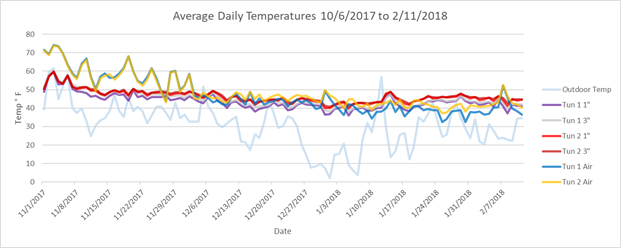
As mentioned above in the Propane Use section, the heating systems were unable to maintain the programmed minimum temperatures during periods of extreme cold, overcast conditions, and/or after sunset. For example, from 5:00 PM 1/5/18 to 9:00 AM 1/6/18, the average outdoor air temperature was 5.76° F. Average ambient air temperature in Tunnel 1 during that time was 29.6° F, reaching a low of 25.5° F, while Tunnel 2 averaged 36.0° F, reaching a low of 29.3° F. A table of all observed temperature minimums, maximums, and averages from 10/6/2017 through 2/11/2018 can be viewed here:
|
|
Outside Air Temp |
Tunnel 1 Air Temp |
Tunnel 2 Air Temp |
Tunnel 1 Soil Temp (1”) |
Tunnel 2 Soil Temp (1”) |
Tunnel 1 Soil Temp (3”) |
Tunnel 2 Soil Temp (3”) |
|
AVG |
36.44° F |
45.71° F |
47.48° F |
47.64° F |
49.51° F |
48.95° F |
49.94° F |
|
Max Temp |
81° F 10/8/2017 3:00 PM |
86.1° F 10/10/2017 2:00 PM |
85.3° F 10/10/2017 2:00 PM |
81.5° F 10/10/2017 2:00 PM |
82.4° F 10/10/2017 2:00 PM |
80.6° F 10/10/2017 4:00 PM |
77.0° F 10/10/2017 3:00 PM |
|
Min Temp |
-13° F 1/7/2018 7:00 AM |
25.5° F 1/5/2018 5:00 PM |
23.4° F 1/6/2018 4:00 PM |
33.8° F (multiple early Jan) |
36.5° F (multiple early Jan) |
35.6° F (multiple early Jan) |
37.4° F 1/1/2018 8:00 AM |
Setting the ridge vents in the two tunnels to begin opening at 60° F helped to regulate large temperature swings of the inside air temperatures and keep humidity levels low. However, that same venting also very likely decreased temperature differences that may have otherwise been observed between the two tunnels.
Soil Nitrate Availability
Soil nitrate levels were not consistently different between the two tunnels. Though it was anticipated that soil nitrate levels may be less dynamic and variable over time during the winter months when the soil microbes that drive the nitrogen cycle slow down, observed nitrate levels actually varied quite a bit from week to week from early October through mid-January. After mid-January when soil temperatures dropped more consistently into the low-to-mid 40s and crops were not utilizing as much nitrate, soil available nitrate levels did stabilize. There was a trend toward higher soil nitrate availability in the warmer tunnel, Tunnel 2, compared to Tunnel 1, after mid-January. See a graph of soil nitrate availability trends over time here:
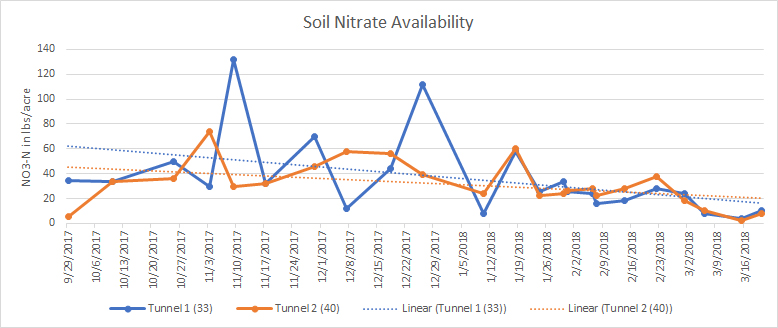
Though no clear relationship between temperature and soil nitrate availability was found during this trial, two observations are worth noting. First, Tunnel 1 (33° F) experienced a flush of nitrate measured on 11/9/17 (prior to any supplemental heating in either tunnel) much higher than the highest measured soil nitrate level in Tunnel 2 (40° F). One hypothesis to explain this is the cropping history difference between the two tunnels. Tunnel 1 was used for high tunnel tomato production into the late summer and, as a result, was irrigated regularly and supported actively growing plants with only a short time gap in the transition to winter greens. In contrast, Tunnel 2 was bare fallowed for over two months prior to being prepared for winter greens. Since Tunnel 2 was allowed to dry out completely and had no plants growing in it, it can be hypothesized that the soil microbial community was adversely impacted and, as a result, less able to mineralize the equivalent input of organic nitrogen fertilizer when compared to Tunnel 1.
Second, soil nitrate availability dropped to near zero by mid-March, even after supplemental Chilean nitrate fertigations of the equivalent of 6.27 pounds of nitrogen per acre on 2/15/18 and 2/28/18. While this may seem to suggest a nitrogen deficient environment, the foliar nutrient analyses (see Nitrogen Uptake below) indicate that plants were actually in the sufficient range for most of the winter season. Given the concerns around salt accumulation in high tunnel soils, carefully managing nitrate availability to match crop uptake and deplete soil reserves may be a prudent high tunnel winter fertility management approach.
Many winter high tunnel growers who either do not use soluble forms of nitrate-nitrogen or are not equipped to fertigate in the late winter/early spring instead compensate for lower mineralization rates over the winter by incorporating higher-than-recommended rates of organic sources of nitrogen before planting (see, for example, Danya Tietelbaum’s presentation from the New England Fruit and Vegetable Conference 2017 proceedings recommending a pre-plant nitrogen fertilization rate of 5 times the suggested field rate at https://unh.app.box.com/s/e3hopz32ci4vlzdxaicdq0317zq6okhq). In addition to the risk of contributing to excessive salt build up, this approach may also be economically less sustainable than moderate nitrogen fertilization pre-plant to support early growth and development followed by controlled fertigations in the late winter. More research is needed on yield impacts, input costs, and infrastructure costs to clarify the advantages and disadvantages of these two approaches to nitrogen fertility management in winter high tunnel production.
Nitrogen Uptake
As indicated above, pre-plant PSNT tests were used to determine the rate of supplemental feathermeal organic nitrogen fertilizer to incorporate into each tunnel prior to planting to reach the equivalent of 70 pounds of nitrogen per acre. Foliar nutrient analyses of all three crops included in the study showed that this rate of pre-plant incorporated organic nitrogen was able to not only support sufficient levels of total nitrogen concentration in leaf tissue until late January/early February, but actually resulted in excessive levels of total nitrogen in all crops until early to mid-December. Graphs illustrating the nitrogen concentration of leaf tissue by crop over the winter can be viewed here:
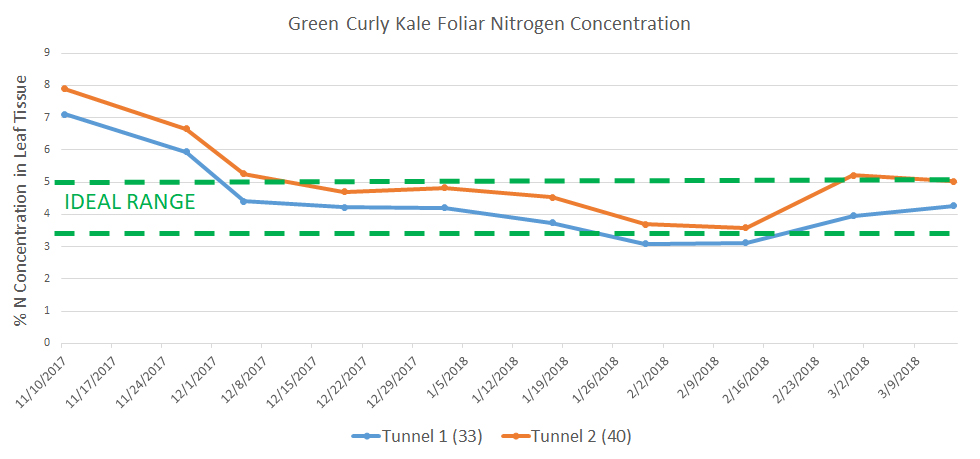
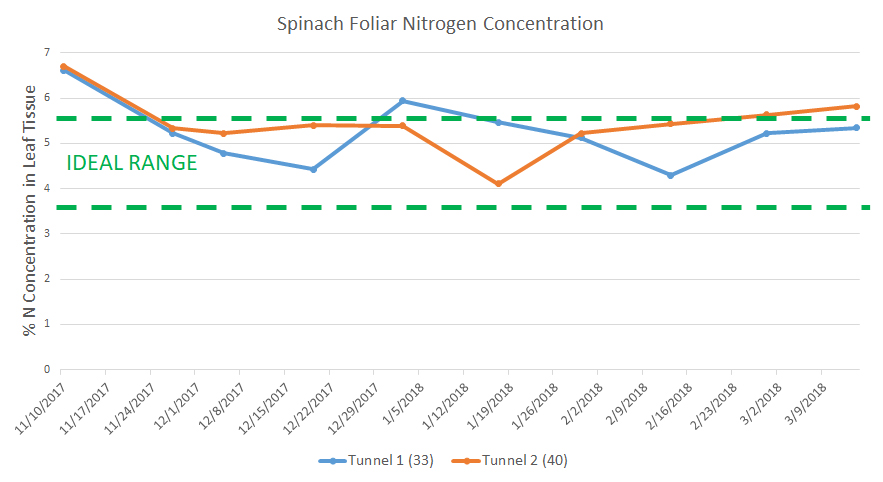
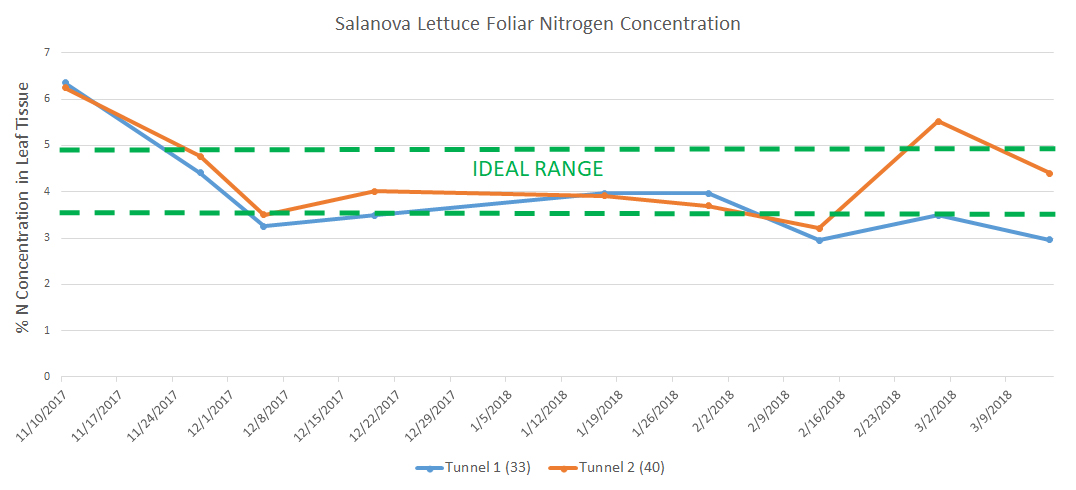
The foliar nitrogen analyses also show the responsiveness of both the kale and lettuce crops to the first fertigation of Chilean nitrate on 2/15/18. Total nitrogen levels for both crops had dropped into the “low” range prior to fertigation, but were both elevated into the “high” range in Tunnel 2 (40° F) after a single application of the equivalent of 6.27 pounds per acre of nitrogen as Chilean nitrate. The spinach crop never fell into the “low” range for total nitrogen in either tunnel during the sampling period of 11/10/17 through 3/20/18.
As with soil nitrate availability, no clear or meaningful relationship between the two temperature thresholds and nitrogen concentration in leaf tissue emerged from the trial. While the total nitrogen levels for all crops tended to be higher in Tunnel 2, especially in the late winter/early spring, that difference was not usually very large. One exception to that statement can be seen in the total nitrogen concentration in the Salanova lettuce variety post-fertigation in late February. As will be discussed below in the Yield section below, this difference of 2% between Tunnel 1 and Tunnel 2 in nitrogen concentration mirrors the difference observed in regrowth in the lettuce crop between the two tunnels. However, more research is required to further explore the relationship between temperature, total nitrogen uptake, foliar nitrogen concentration, and potential impact on yield.
Yield
Unfortunately, the utility of the yield data that was collected by the employees of the Poughkeepsie Farm Project was compromised by the incremental nature of the harvest (cut for order only, not the entire plot at a time) and because of serious pest and disease pressure in the plots. Also, since there was no opportunity to use a randomized complete block design given the infrastructural restrictions on farm, it is difficult to draw meaningful conclusions about the observed differences in yield (it is possible that measured differences are the result of inherent variation in yield from plant to plant rather than the treatment effect of temperature manipulation between the two tunnels). More detail on pest and disease pressure is provided below in the “Other Observations” section. The total observed yield per square foot from the first recorded harvest on 12/4/17 through 3/19/18 for each of the three crops can be viewed in the table here:
|
Total Yield Per Square Foot in Pounds 12/4/17-3/19/18 |
|||
|
|
Curly Kale |
Salanova Lettuce |
Spinach |
|
Tunnel 1 (33° F) |
0.5759 |
0.4125 |
0.2768 |
|
Tunnel 2 (40° F) |
0.6042 |
0.545 |
0.375 |
It should be noted that the farm continued to harvest spinach after the final observation date of 3/19/18, but not lettuce or kale (bolted).
One interesting observation emerging from the trial was the difference between the two tunnels in how quickly the Salanova lettuce regrew after the first and second cuts. Following the first harvest of Salanova in the tunnels on 12/4/17, the warmer high tunnel, Tunnel 2, was ready for harvest again by 2/14/18. The Salanova lettuce in Tunnel 2 regrew quickly enough to support a third harvest after 3/6/18. In contrast, the Salanova lettuce in Tunnel 1 (33° F) was only ready for second harvest the week of 3/6/18. In essence, the warmer tunnel supported sufficient regrowth rates in the Salanova lettuce to allow three harvests from 12/4/17 through 3/10/18, while the cooler tunnel only supported two harvests during the same period. This difference in regrowth rate and harvest between the two tunnels can be observed in images here:
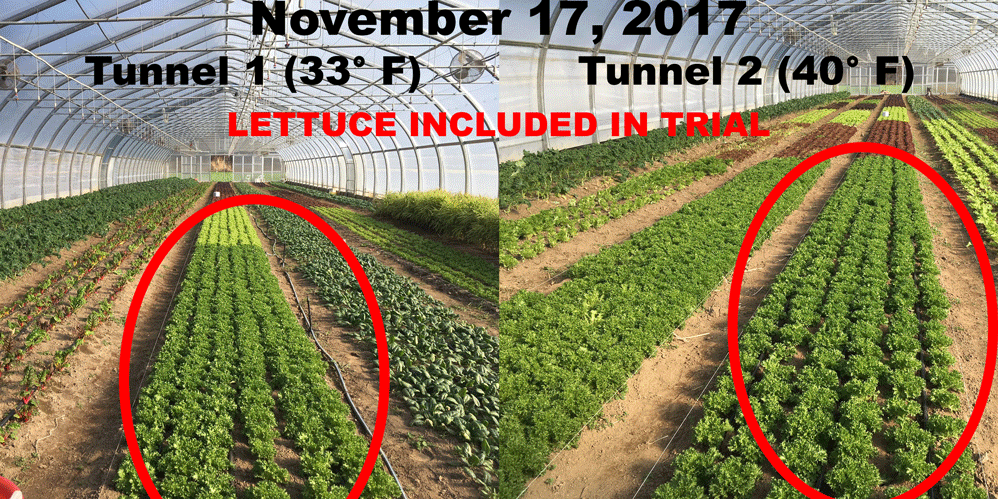
Given that these trials were not replicated and taking into account the other factors that compromised the yield data described above, it is irresponsible to draw conclusions regarding the potential economic impact of the additional heating and its resulting impact on crop yield. However, given the interest in this subject, a conservative estimate can be made with the data collected. First, assume that 50% of the difference in yield per square foot in Salanova lettuce observed between the tunnels can be attributed to the warmer growing environment. Second, assume that the entire planted square footage of each tunnel was entirely dedicated to Salanova lettuce transplanted on 10/9/17. Finally, assume that all Salanova lettuce is sold to wholesale markets at an average price of $9 per pound, based on the actual price obtained by the Poughkeepsie Farm Project in the winter of 2017-18. Given these three assumptions, it can be calculated that the yield increase attributed to heating of .06625 pounds per square foot observed in Tunnel 2, multiplied by 5208 square feet of planted area in Tunnel 2, results in an increase in 345.03 pounds of harvested Salanova lettuce from 12/4/17 to 3/12/18. At $9.00 per pound, the additional yield would result in an increase in gross revenue of $3,105.27 from Tunnel 2 compared to Tunnel 1. Given that the estimated increase in propane cost to heat Tunnel 2 was $3,073.39, the resulting difference in net revenue is just $31.88 more for Tunnel 2. Again, the author cautions readers that more research and replication is required to support this economic analysis.
Other Observations
Pest and disease pressure skewed yield data in all three crops. Brassica powdery mildew was severe on the kale early on, but mostly controlled with a single sulfur application in October. However, the heavy residue left from the sulfur rendered some of the earliest mature leaves unmarketable, so they were not included in the yield data.
Despite applications of potassium bicarbonate and hydrogen dioxide/peroxyacetic acid formulations after symptoms were observed, lettuce powdery mildew became severe by late December. No formal data was collected, but the employees of the Poughkeepsie Farm Project reported that the lettuce powdery mildew appeared more severe in Tunnel 2 (40° F) compared to the severity in Tunnel 1 (33° F). It was not apparent that the higher temperature threshold was singularly responsible for the more severe presence of lettuce powdery mildew in Tunnel 2; Tunnel 2 had more total lettuce being grown in it over the winter, had lettuce grown in it later into the previous spring than in Tunnel 1, and was also physically closer to the field where lettuce was grown in the late fall where inoculum may have developed.
Botrytis crown rot caused by the fungal pathogen Botrytis cinerea was responsible for a serious decline in yield, especially after the first cut of Salanova lettuce. Again, despite not formally measuring disease severity, it was easily observable that the botrytis crown rot was far more severe in Tunnel 1 than in Tunnel 2. This difference in disease severity is likely because Tunnel 1 had been used to grow tomatoes during the summer and had experienced a moderate level of botrytis ghost spot (also caused by Botrytis cinerea), giving the pathogen population an opportunity to grow year round, whereas Tunnel 2 was left fallow most of the summer. Images of both botrytis crown rot and powdery mildew of lettuce can be viewed here:
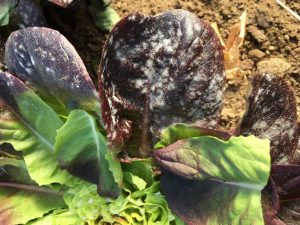
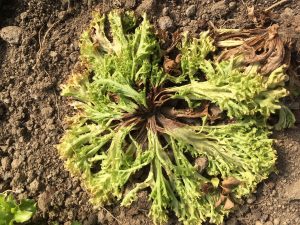
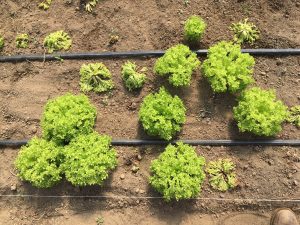
Finally, beet or serpentine leafminer damage was excessive in the spinach in both tunnels. As a result, the first cutting of spinach was discarded completely and not accounted for in the yield data.
The most important conclusions to emerge from the trial are:
- Lower than recommended rates of pre-plant incorporated feathermeal provided sufficient nitrogen to all leafy greens in the study through January.
- After becoming slightly nitrogen deficient according to foliar nutrient tests in early February, all crops in the study were brought back into the ideal or high range for nitrogen concentration with 2-3 targeted supplemental fertigations of soluble nitrate in February and March.
- Reducing pre-plant incorporated nitrogen and planning supplemental fertigations in the late winter may be a more economical and environmentally sustainable fertility management approach for winter grown greens than front-loading all nitrogen fertility in the fall. Excessive foliar nitrogen accumulation in the early winter growing season can result in luxuriant growth that makes crops more susceptible to foliar diseases, more attractive to insect pests like aphids, and more prone to suffering physiological disorders like tip burn. Reducing total nitrogen fertilization rates can also help mitigate the common concern in high tunnel production of salt accumulation over time.
- There was no obvious economic advantage to increasing the temperature from 33° F to 40° F in this trial. The trends toward increased yield did not sufficiently outweigh the increased cost of propane use for additional heating. However, more research is required to further assess the economic impacts of supplemental heating in winter high tunnel production.
- Field use history has an impact on soil nitrate availability in winter high tunnel production. Maintaining adequate soil moisture and living roots, as opposed to bare fallowing, can support the soil microbial community responsible for nitrogen mineralization. The difference in soil nitrate availability between Tunnel 1 and Tunnel 2 observed in the late fall is likely attributable to this phenomenon. If high tunnels are not being used for cash crop production prior to winter production, it may be advantageous to establish an irrigated cover crop in that environment to sustain the soil microbial community. However, more research is required to further assess the potential benefits and impact on nitrate availability of cover crops in high tunnels.
Education & Outreach Activities and Participation Summary
Participation Summary:
The education and outreach associated with this project predominately fall into the commonly used extension methods of presentations, newsletter articles, and workshops. First, Judson Reid, Ethan Grundberg, and Leon Vehaba delivered six presentations combined using data collected from this project. Reid presented at the 2018 and 2019 Empire State Producers Expo in Syracuse, NY to a total of 50 growers. The 2018 proceedings from the High Tunnel session can be viewed at http://www.hort.cornell.edu/expo/proceedings/2018/HighTunnel_Best%20Management%20Practices%20EXPO18_HTBMPs.pdf and the 2019 presentation slides can be viewed in this PDF: Reid_EXPO19_HTgreens.
Vehaba presented findings from the trial during a high tunnel soil health session hosted by Glynwood in Cold Spring, NY on March 23, 2018 to a group of 35 farmers. Grundberg also presented findings on soil nitrate availability and its relationship to field use history to a small group of Glynwood apprentices (3 total) during a cover crop presentation on September 12, 2018. Grundberg also shared preliminary results from the research with the entire staff of the Poughkeepsie Farm Project (9 total) on April 6, 2018. Finally, Grundberg used some data and images collected during the trials as a basis for a High Tunnel management presentation given at the Catskill Regional Agricultural Conference in Delhi, NY on January 10, 2019 to a group of 32 growers.
Both Grundberg and Reid published extension newsletter articles pertaining to the results of this research. Grundberg authored a short synopsis of initial observations from the trials in the Eastern New York Veg News on April 25, 2018 that can be viewed here: ENY-Veg-News-6.2-Grundberg-Winter-Greens-Heat. Grundberg published a more comprehensive article in the Eastern New York Produce Pages in November 2018 that can be viewed here: ENY-Produce-Pages-Nov-18-Grundberg-Supplemental-Heat-HT-Greens Reid used some of the findings from this study to inform a piece published in the Cornell Vegetable Program Veg Edge newsletter in the February 2019 edition that can be viewed here: VegEdge-newsletter-–-Vol.-15-Iss.-02-2_4_19-Reid-Winter-HT-N It is estimated that Grundberg and Reid reached a combined 250 growers in New York through their newsletter articles.
The capstone outreach effort to emerge from this grant was a Winter High Tunnel Production Farmer to Farmer Workshop held at the Poughkeepsie Farm Project on February 4, 2019. 92 growers, service providers, and industry representatives met in Poughkeepsie to discuss topics like high tunnel site preparation, heating systems, fertility management, pest and disease management, and more during the day-long session. Vehaba led a tour of the high tunnels at the Poughkeepsie Farm Project for all attendees and highlighted some of the findings from the SARE partnership grant research. Two local media outlets ran stories featuring the meeting: the Hudson Valley News Network with circulation of over 45,000 https://hudsonvalleynewsnetwork.com/2019/02/25/poughkeepsie-farm-project-hosts-high-tunnel-summit-farmer-to-farmer-training/ and Citybizlist with online viewership of over 90,000 https://newyork.citybizlist.com/article/530609/poughkeepsie-farm-project-hosts-high-tunnel-summit-farmer-to-farmer-training.
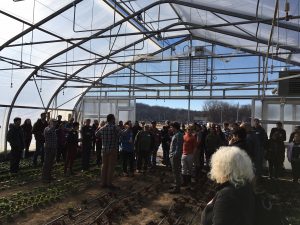
Learning Outcomes
- Potential for fertigating with Chilean nitrate in spring instead of front-loading fertility pre-plant in late summer/fall
- Economics of using propane heating instead of row cover for winter temperature protection
- Foliar nutrient testing methods and value
- Recognition of and management strategies for botrytis crown rot
- Recognition of and management strategies for lettuce powdery mildew
- Using forced air heating to manage humidity as well as temperature in winter greens production
- Better understanding of nitrogen cycle
Project Outcomes
Based on the results from the research conducted during the winter of 2017-18, the Poughkeepsie Farm Project decided to set the thermostats in each tunnel to 35° F for the majority of the 2018-19 winter season. The decision was informed by the desire to improve yield and increase nitrogen uptake compared to the 33° F threshold used in Tunnel 1 in the study, but not incur the additional expenses from increased propane use that was observed in Tunnel 2 in the study with a thermostat setting of 40° F. Though no data was taken in 2018-19 to track foliar nitrogen concentration or yield, the hope was to improve the economic sustainability of winter production at the Poughkeepsie Farm Project by responsibly using propane as an input to improve yield in leafy greens production.
Additionally, the Poughkeepsie Farm Project used the data generated in this study to support a further reduction in pre-plant incorporated nitrogen fertilizer for winter production in 2018-19. The farm reduced the target of available soil nitrate from 70 pounds per acre to 60 pounds per acre and, instead, planned an additional fertigation of Chilean nitrate in late February/early March 2019 if necessary.
Finally, though only tangentially related to the specific scope of the trial, the Poughkeepsie Farm Project adopted a preventative lettuce powdery mildew fungicide program during the winter of 2018-19 based on the observations and recommendations emerging from the SARE partnership grant-funded trial. As a result, the farm successfully eliminated all symptoms of lettuce powdery mildew in 2018-19 by proactively applying crop protectants. This also resulted in an overall reduction in the total amount of fungicides used to manage lettuce powdery mildew compared to 2017-18.
Conducting on-farm trials always requires a degree of compromise between best scientific field research design and practice and the realities of cooperating with a commercial operation. Ideally, similar research could be replicated using a randomized complete block design to better evaluate the impact of supplemental heat on leafy green yield and nitrogen uptake over the winter. The pest and disease pressure that compromised the value of the yield data was also a serious challenge to interpreting the observational data gathered. Again, future trials on a research farm where yield can be more carefully measured might yield more sound data.
That said, the trial did contribute importantly to a growing body of research aimed at better understanding best fertility management practices for winter high tunnel production. The foliar nutrient analyses collected during the study helped to support theoretical trends in nutrient uptake and availability over the winter. Perhaps most importantly, clear data supporting the efficacy of targeted fertigations of soluble nitrate in the late winter/early spring emerged from the trials and can help support efforts to encourage responsible nitrogen fertility management in winter production systems.
Based on conversations with other growers experimenting with supplemental heating in winter greens production, there is a strong desire and need for further research evaluating more temperature thresholds (particularly “bare minimum” supplemental heating at 25° F just to prevent crop injury), the use of supplemental heating during confined periods of faster plant growth in the fall and early spring (not late December through early February), the economics of supplemental lighting and carbon dioxide systems to enhance the yield impact of supplemental heating, and environmental and economic impact research on different heating systems that can be used in winter high tunnel leafy greens production. Despite this clear need for continuing research, winter high tunnel growers in the Northeast should benefit directly from the information generated from careful tracking of propane use and nitrogen uptake trends over the winter from this study.